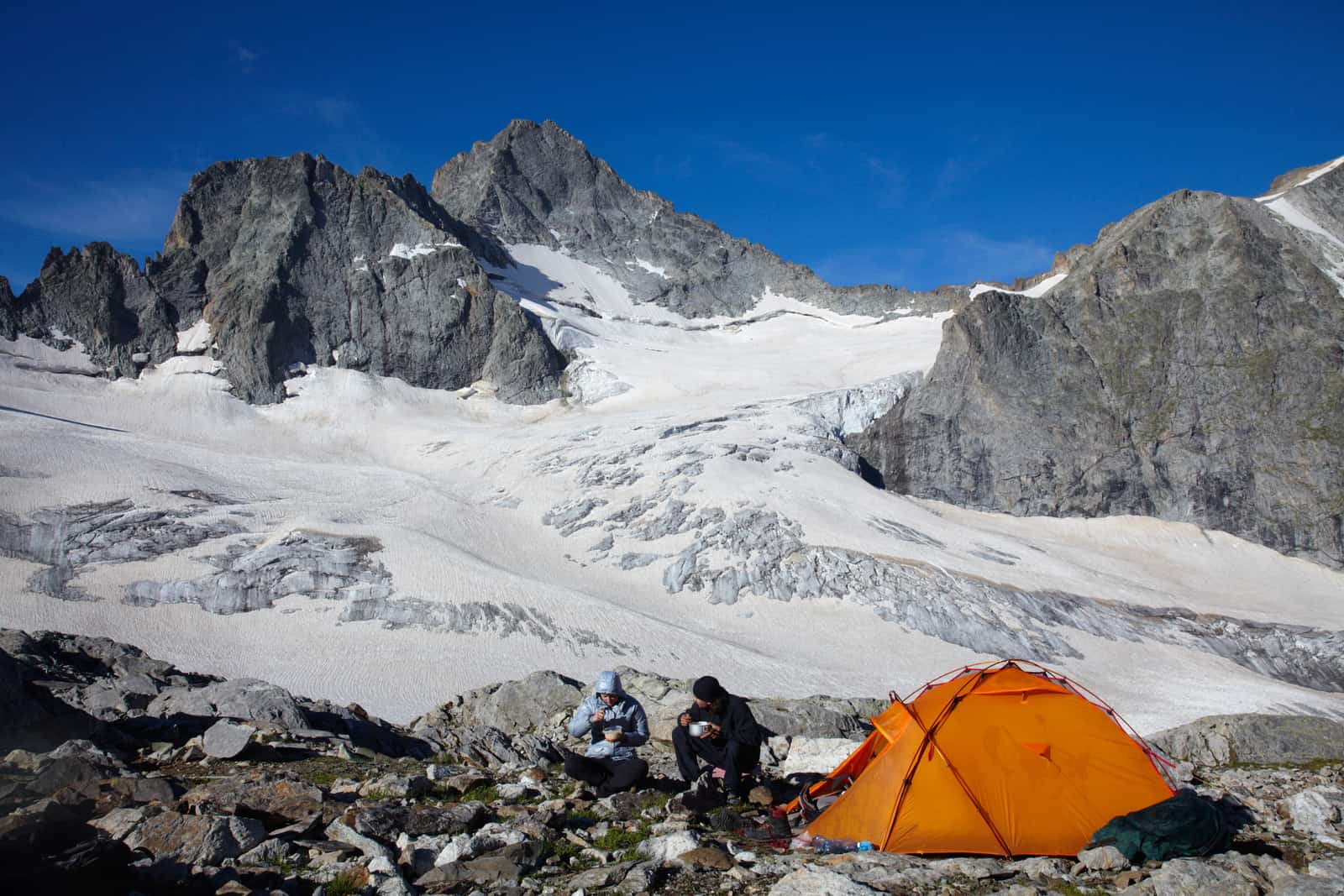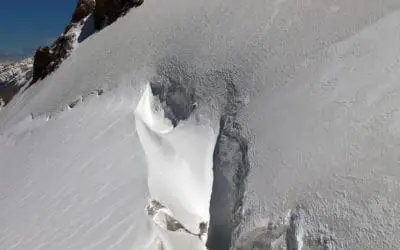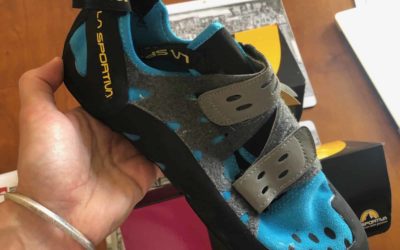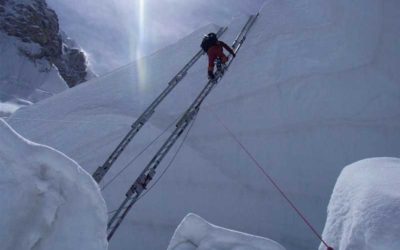
Despite what you may think not all pro mountaineers are tea totting granola crunchers. The day to day work of a guide is rather low end and clients generally are not all that fit even though they think they are.
Guides are very efficient with their energy and even competitive marathon/ironman clients collapse long before that beer drinking pizza loving guide. Partly because of the energy efficiency and partly because of the specific muscle groups being used.
The food really depends on the kind of climbing, the environment, and personal tastes. Pro mountain climbers tend to emphasize the importance of calorie-to-weight ratio the harder the climb is. Some pros take nothing but dehydrated foods, while others insist on fresh fruits and veggies, which while heavier, tend to be more palatable. One of my buddies who guides even brings along vacuum sealed, precooked, chicken. The weight-to-calorie ratio is through the roof on something like that.
Lets have a look at what experienced mountaineers prefer to eat on the mountain and what to consider before prepping your lunch for the mountains:
Mountaineering Food: Factors To Consider
Food is treated no different than any other equipment a climber might carry. Some decision points to consider are calories, price (climbing is not one of the most lucrative careers), weight, viability in the mountains, nutrition, and personal preference.
Food-Related Mistakes Commonly Made On The Mountain
So take for example something like a potato. It is a calorie-dense food that is relatively lightweight and cheap. But if you showed up to base camp on the side of a mountain and started to boil a potato, I assure you, you would never hear the end of it.
Because altitude raises the boiling point, it will take longer to cook. And second, a longer cook time means that much more fuel you will have to bring. Lastly, the more time you spend cooking, the less time you spend sleeping (which is so important on a climb) or climbing.
”Professional” Mountaineering Food
Below are listed examples of what to bring for each meal in the mountains.
Everything is sorted by its calorie-to-weight ratio (or energy-to weight ratio) since this is of importance to any serious mountaineer. I hope these lists will help you in deciding what to pack for your climb.
Breakfast |
Calorie | Weight | Ratio |
| Breakfast Mix | 210 | 1 serving/bag (43 g) | 138 |
| Granola | 132 | 1 oz (28 g) | 132 |
| Trail Mix | 131 | 1 oz (28 g) | 131 |
| Pop Tarts | 120 | 1 oz (28 g) | 120 |
| Protein Bar | 331 | 1 bar (80 g) | 118 |
| Instant Oatmeal | 151 | 1 packet (41 g) | 104 |
| Dried Fruit | 102 | 1 oz (28 g) | 102 |
| Energy Bar | 140 | 1 bar (40 g) | 99 |
Snacks |
Calories | Weight | Ratio (Cal/W) |
| M&Ms Peanut | 90 | 0,35 oz (10 g) | 257 |
| Mixed Nuts | 172 | 1 oz (28 g) | 172 |
| Chocolate Bar | 406 | 1 bar 2,6 oz (73 g) | 157 |
| Banana Chip | 147 | 1 oz (28 g) | 147 |
| Chips/Crackers | 504 | 3,5 oz (100 g) | 144 |
| Snickers Bar | 215 | 1,56 oz (44 g) | 138 |
| Trail Mix | 131 | 1 oz (28 g) | 131 |
| Beef Jerky | 116 | 1 oz (28 g) | 116 |
| Candy (Jelly Beans) | 105 | 1 oz (28 g) | 105 |
| Dried Fruit | 102 | 1 oz (28 g) | 102 |
| Energy Bars | 140 | 1 bar (40 g) | 99 |
| Raisins | 85 | 1 oz (28 g) | 85 |
So most climbers try to bring food that is easy to prepare, provides a good mix of nutrients, is relatively cheap, low weight, and still tastes good.
For snacks, you want something that is easy to eat at any time, is calorie-dense, and contains simple sugars for that immediate energy you need.
The first place to start is nuts. Nuts are mostly a fat source. Fats give you 9 calories for every gram of fat. Carbs and protein give you just 4.
Nuts are also lightweight, everyone loves them, and they can usually withstand getting tossed around in your pack and are easy to eat right out of the bag. And if you go with peanuts (ok not technically a nut, but it still works) they are relatively cheap. Or buy them in bulk.
Another great food item is candy. Things like snickers, M&M, gummy bears, and cracker jacks all work great.
Will Gadd, one of the most prominent ice climbers of this generation, recommends cracker jacks and snickers because they have the perfect ratio of carbs to fat.
Mountaineering Lunch Guidelines
Lunch |
Calorie | Weight | Ratio |
| Summer Sausage | 426 | 3,52 oz (100 g) | 121 |
| Hard Cheese | 392 | 3,52 oz (100 g) | 111 |
| Salami | 336 | 3,52 oz (100 g) | 95 |
| Honey | 304 | 3,52 oz (100 g) | 86 |
| Bagels | 250 | 3,52 oz (100 g) | 71 |
| Wheat Tortillas | 237 | 3,52 oz (100 g) | 43 |
And if you are considering buying one of those expensive cliff bars, there’s no need to actually purchase one, and I’ve never seen a pro-climber actually eat one.
While there is nothing really wrong with a cliff bar (or similar product), you can easily substitute a fig newton, which is far cheaper and keeps its form after being tossed around in your pack and is still easy to eat. I got this idea from a buddy of mine who used to guide in the Cascades.
Other items that work well are jerky, bagels, and hard cheese. They all last a long time, maintain their shape, affordable, and lightweight.
With cheese and bread have high salt content, so you will have to make sure you are drinking plenty of water, and since jerky is dehydrated, your body has to reconstitute it before digesting, so there again make sure you are drinking plenty of water.
Mountaineering Dinner Guidelines
Dinner |
Calorie | Weight | Ratio |
| Instant Stuffing | 150 | 1 oz (28 g) | 150 |
| Ramen Noodles | 436 | 3,52 oz (100 g) | 124 |
| Freeze Dried Meals | 500-900 | 5-7 oz | 100-130 |
| Rice Sides | 230 | 2,12 oz (60 g) | 109 |
| Easy Mac | 230 | 2,12 oz (60 g) | 109 |
| Pasta Sides | 210 | 2,12 oz (60 g) | 100 |
| Instant Potato Flakes | 70 | 0,7 oz | 100 |
| Dry Soups | 119 | 1 packet (40 g) | 85 |
| Chicken | 239 | 3,52 oz (100 g) | 68 |
| Couscous | 112 | 3,52 oz (100 g) | 32 |
| Tuna | 194 | 6,5 oz | 30 |
| Freeze Dried Veggies | 20 | 3,52 oz (100 g) | 6 |
Extras |
Calorie | Weight | Ratio |
| Olive Oil | 884 | 3,5 oz (100 g) | 252 |
| Powdered Drinks | 411 | 3,5 oz (100 g) | 117 |
| Condiment Packets | 20 | 1 packet (9 grams) | 57 |
| Hot Chocolate | 77 | 3,5 oz (100 g) | 22 |
| Seasonings | 5 | 3,5 oz (100 g) | 1,4 |
| Hot Sauces | 0-100 | 3,5 oz (100 g) | 0 |
Don’t Save Your Sandwich
If you are walking/climbing up something that is a long day out in the UK e.g., Ben Nevis then eat a hearty carbohydrate-packed breakfast with lots of liquid and make sure you have spent the previous evening getting hydrated.
Don’t save your lunch sandwiches for the top, eat them at the bottom (and have a carbohydrate filling, not cheese, you won’t digest the fat in time to turn it into energy – I like marmalade and banana).
Stuff you pockets with e.g., fig rolls/Mr Kipling cakes etc. The top’s the place for extra sandwiches/the banana, nuts and chocolate. (It’s a bit like the preparation and aftermath for/of donating blood.)
Some people carry extra chocolate as their emergency food and as it gets devoured in non-emergencies they hopefully remember to replace it.
The alternative is to put something in the rucksack that is such a faff to open that you are not tempted, my choice is small Christmas puds purchased in the post-Christmas sales. Or those very sticky packets of dried bananas.
Shortlist of Lightweight Mountain Climbing Foods
Here are a few favorites that can’t go wrong:
-
Granola bar
-
Light and watery foods like biscuits
-
jelly ace
-
Peanut butter
-
Chocolate
-
Marmalade, honey and banana
-
Fig rolls
-
Mr Kipling cakes
-
Nuts and dried fruit
-
Packets of dried bananas
-
Small Christmas puds
If you are asking about those kinds of expeditions where you disappear into the wilderness for some days (along or up) carrying all food with you then the issue is weight and energy/nutritional requirements by how many days. And in snow, you will have to carry fuel to melt drinking water as well as for cooking food.
Andy Kirkpatrick was the BMC rep at one of the winter safety seminars who recommended the a) eating lunch sandwiches at the bottom to aid getting up and b) stuffing pockets with small cakes/biscuits. (Point about Mr K cakes is they are individually wrapped but any similar brand will do.
I carry packets of fig rolls and shovel them into pockets at stops, crumbs can be contained in sandwich bags.)
What Pro Mountaineers Drink
For drinks, I carry a bladder that I can sip Gatorade from while I am on the move. (This may be the most important thing I have going).
Back in the day I used phoo phoo the things but carried a litre of water and at the end of the day I had 1/2 litre left. With the bladder, I carry 2 litres and am done with it 3/4 of the way through the day. This much depends on the wheres and the hows though.
More Mountaineering Food Tips
This is another of those questions that is way out of that useful location, context. Are you perhaps related to the person who asked about the kind of sneakers one needed to ‘climb mountains’? (BTW Climbing and mountaineering are two different things).
You basically need to do your carbohydrate loading in the morning meal and don’t underestimate your calorie intake. Eat more.
I do carry a few of those stupid power/cliff bars as a last recourse to get me through the end of the day or to fuel a client who thinks they have hit the wall. “I can’t take another step” usually means to me I can get another half day out of them.
Having Sufficient Liquids on The Mountain
I mean as long as you can carry it then what’s the problem right? Well, that might be true, but I would recommend staying away from sugars and sticking to water. Boring as may be.
You will not be able to carry sufficient liquid for your day’s hydration needs for high level walking in many places, regardless of whether you got to the top shimmying up rock/ice or plodding up.
No snow, I top the flask up with water from (high) streams as do my companions but in snow you may have a water deficit.
(There are some remote huts where driving up to a short walk from the front door and emptying out a large group supermarket shop is not feasible so good advance planning needed for the walk-in even if returning to a base each day; what goes in must be eaten/come out).
How Much Food to Pack for a Climb
Depends on the length of the climb, but basically everything. High energy diet for high energy output.
Shorter climbs with only a day or two out to attack the summit allow for efficient packing.
Dehydrated food is convenient and only requires boiling water. Lots of protein and candy bars, and dried fruit and nuts.
The BMC (British Mountaineering Council) tours UK cities in the autumn with an evening of lectures on good practice in winter mountaineering, including food. If you are in the UK go to them. Ditto Lochaber (Scotland) at Feb half-term, you will find a safety seminar evening under the auspices of the Mountaineering Council of Scotland.
Conclusion
Diet and foods are always tough subjects since they differ and depend so much on the individual and the circumstances.
I am an example of someone who can eat cold pizza and coffee for breakfast and still feel fully energized when taking the first step upwards. That being said, I don’t recommend doing that.
For drinks, try to stick to water. However, I know some people who take some flavored waters up the mountain, and it seems to work well for them.
The most important thing is that you don’t get dehydrated, and some flavor in your drink may make you less inclined to forget about staying hydrated.
Find what works for you. Generally, stick to high and dense caloric foods. Remember that we are after the energy, not the perfect summer body. Happy adventures!
Written by Felix

About me
Hi! I’m Felix. When I’m not spending time out in the mountains, I like to write about my hobbies. That is how Mountain Homies was created. On this site, I try to gather all the juicy information about Mountaineering that I have learned since I started. Happy adventures!
Related Articles
3 Ways to Spot and Reveal a Crevasse (And Avoid It)
So, how do you spot a crevasse and – more importantly – avoid falling into one? In this article, I will have a look at what crevasses are and how to detect them…
5 Ways of Knowing If Your Climbing Shoes Are Too Big
It has almost become a prestige among climbers to be able to boast about how small and tight climbing shoes can be used. There is therefore a lot of talk…
3 Clever Ways of Crossing A Crevasse
When you’re mountaineering in snow country, you will undoubtedly encounter some crevasses. These are scary, since you don’t always spot them…
Stay Up to Date With The Latest News & Updates
Join Our Newsletter
The owner of this site is a participant in the Amazon Services LLC Associates Program, an affiliate advertising program designed to provide a means for sites to earn advertising fees by advertising and linking to amazon.com.



